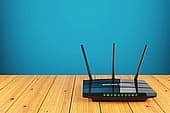How to find the best broadband deal for you
How does Choose compare broadband deals?
Choose aims to help people around the UK better compare broadband deals by offering comprehensive comparison searches and tables.
We include both broadband only and broadband and phone packages in the search above, which can be filtered based on your own preferences. It's also possible to compare broadband & TV bundles with Choose as well.
Our aim is to supply you with clear information about the latest home broadband deals and current special offers for new and switching customers so that you can make an informed decision when you choose your next broadband package.
The broadband deals we list are frequently updated to ensure customers get a clear picture of the offers available on the market that day.
We also list the deals by price or by fact, and never by referral revenue, so you can trust you're seeing an accurate representation of what's available. To change how deals are ordered, simply use the 'sort by' drop down at the top of the comparison table.
The filter available can also help to find the right deal for you based on the broadband speed you need; whether you want a home phone line and any free calls; the contract term you can commit to; and whether you prefer any particular providers.
We cover the wider broadband market where we can, so that customers can compare broadband prices from all of the major providers, as well as many location specific full fibre networks, like KCOM in Hull and Community Fibre in London, among others.
On this page, you can find deals from a range of broadband providers, including:
- Sky
- Virgin Media
- BT
- TalkTalk
- Vodafone
- NOW Broadband
- Plusnet
- Rebel Internet
- Earth Broadband
- Fibrely
- Hyperoptic
- Direct Save Telecom
- iTalk Telecom
- Pop Telecom
- KCOM
- Community Fibre
- Gigaclear
- Fibrus Broadband
- BeFibre
- Your Co-op
- Hey! Broadband
- LightSpeed Broadband
- Lit Fibre
- Trooli
- Airband
- Quickline
- 4th Utility
- Brdy
- Brsk
To see what's available at your location make sure to enter your postcode in the form field at the top of the page. This will filter out any deals that aren't available to you, so it's easier to find the best broadband deal from a provider with coverage where you live.
In some areas, we'll also return fixed-wireless, satellite, and 5G home mobile connections where this is relevant to do so, particularly in more rural or harder-to-reach areas without any full fibre coverage. Read more about getting broadband in rural areas here.
Lastly, please remember that the monthly prices shown will assume that payment is made by direct debit, which may also be a required payment method by many of the providers listed.
What is the cheapest price for broadband?
The UK broadband market is very competitive with low prices available for no-frills broadband connections and superfast download speeds.
To find the cheapest broadband package available to you, enter your postcode and then sort by deals by 'Lowest price' in the sort by drop down at the top of the comparison table.
This will order all of the deals available to you by price, with the lowest cost deal first. Any introductory prices are considered and averaged out over the length of the contract, and we also calculate the cost of the setup fee too. If two packages both have the same monthly price and setup price, we then list the package with the fastest broadband speed first.
When comparing broadband providers by price, it's important to consider a few factors before deciding on the best deal for you:
- What is the monthly price of the deal?
- How much is the setup cost to get connected?
- Will any annual price rises be applied and how much will they be?
- How long is the contract and how long can you commit for?
While our comparison table orders deals by the monthly price and setup price, any mid-contract annual price rises also need to be considered.
We include the details of these in the table above, but they may consist of either a pounds and pence-based increase, an increased based on future inflation, or they may not yet be known at all, just that prices could go up.
It's also a good idea to consider contract length and how long you can commit to a package for. Ending a broadband contract early can incur early termination fees, and this could even apply where you move outside of the coverage area of a provider within a minimum term.
On the flip side, a longer contract term can also mean the new customer pricing stays in place for longer before out of contract pricing will apply and therefore needing to recontract or switch to another provider.
Lastly, if you're struggling to afford your broadband bill, social broadband tariffs can offer help to those in receipt of certain means-tested benefits, helping to offer a lifeline to allow people to stay connected through tough times.
Social broadband tariffs can offer fixed-line broadband connections for as little as £12.50 to both new and existing customers, so being in a contract already won't hold you back from getting help. Read more about social tariffs in our main guide.
Does Choose include special offers on new deals?
We keep our broadband deals updated regularly and will include any special offers available to new customers in the comparison table above.
Special offers are highlighted at the top and bottom of each result card, and where there is a list of offers, including any relevant ending date of the main offer.
To find broadband deals with the best special offers, order the results by 'Special offers' in the sort by drop down at the top of the comparison table. Where applicable, this will order results by the value of the special offer, with the highest value offers listed first.
What to look out for - special offers on broadband deals can include any of the following:
- Reduced monthly prices
- Reduced or waived setup fees
- Bill credit - where a credit amount is added to your bill
- Reward cards and vouchers
- Bundled services included at no extra cost
- Free gifts, including electronic items such as game consoles and TVs
It's most common to see reduced monthly prices on broadband deals, but special offers do change regularly and bigger rewards are sometimes offered.
However, regardless of any special offer, it's always important to ensure the broadband deal you're choosing is right for you and doesn't include services you don't really need. Opting for a broadband deal purely based on the special offer can be a false economy, so make sure to check out other factors like the on-going monthly price and broadband speed.
Read more about the latest special offers on broadband.
What broadband speed should I choose?
The choice of available broadband speed is increasing for many homes, with 83% of homes now able to access gigabit broadband and the average UK download speed now sitting at 223Mb per second according to Ofcom.
Where full fibre broadband is available most households are choosing 100Mb - 299Mb deals, which is around the entry-level and often the cheapest plans too.
100Mb will be adequate for most households, comfortably supporting activities like streaming in HD and Ultra HD, online gaming, and working from home.
Where households may want to start looking at faster deals, such as 500Mb and 1Gb plans, is where multiple occupants will be going online at the same time, often carrying out bandwidth heavy activities like gaming, streaming, and working online on different devices simultaneously.
Big families and houseshares. therefore, will be more suited to faster deals on 500Mb to 1Gb plans where they're available.
Read more about what broadband speed you need in our full guide.
How fast is my current broadband deal?
If you want to find out how fast your current broadband deal is we have a free broadband speed test tool here which will test your connection for download and upload speeds, and latency.
Test the speed of your broadband connection.
Those on existing part fibre connections, where the internet comes through the old telephone line, are likely to have broadband speeds around 30Mb to 70Mb, however, distance and how far your property is from the nearest street cabinet and local telephone exchange can impact this.
Moving to full fibre broadband can mitigate speed loss over distance as the fibre optic cable is installed directly to your home resulting in faster and more reliable broadband speeds.
Can I keep my home phone line?
Whether or not you can keep your home phone number when you switch broadband deals will depend on the broadband deal you choose.
Due to the move from the old copper phone line network to digital phone lines, it's important to choose a broadband deal with a bundled home phone line if you want to keep that service, as many deals are now only offering a data-only line.
We list in the comparison table above which packages come with a home phone line, and which don't, and it's also possible to filter deals by home phone too.
Where a plan says it comes with a home phone line, the cost of that is included in the listed monthly price, so there is nothing extra to pay for line rental.
Inclusive calls may also be an optional extra that can be added at the checkout, but we try and include these deals in the comparison table as well, so filter by off-peak or peak calls if you also want free calls included in the deal.
How long will it take to switch broadband providers?
Switching between two different broadband providers usually takes around 14 working days, and the new One Touch Switch system means all switches are now gaining provider led.
What does 'gaining provider led' mean? This means to switch broadband deals the customer just needs to choose a new broadband package and place an order. Then, the 'gaining provider', or new provider, handles the switch for them, including contacting their existing supplier and cancelling their existing service on the same day their new service is set to go live.
The new switching system helps to better handle switches between different networks, such as where a customer is moving from BT to Virgin Media, or from an Openreach network to a new local full fibre network.
So, to order a new broadband deal, use the free comparison search above to find the best broadband deal for you and simply place an order online. Once that's done, your new provider will handle the rest for you and be in touch with your switch date.
How do I find more information on broadband?
Have more questions? Choose has been covering the broadband market for over 20 years and we have a range of comprehensive and thorough guides to everything you need to know about broadband.
We've covered topics from how to improve broadband speeds; how broadband contracts work; how to switch broadband providers; and much more.
You can search all of our content for the information you need, or browse our archive of broadband guides here.
Related comparison
Latest news

03 July 2025
Virgin Media gives away free Hisense 4K Smart TV
01 July 2025
NOW Hub Two router support coming to an end
30 June 2025
Sky offers £100 voucher with Glass TV





























